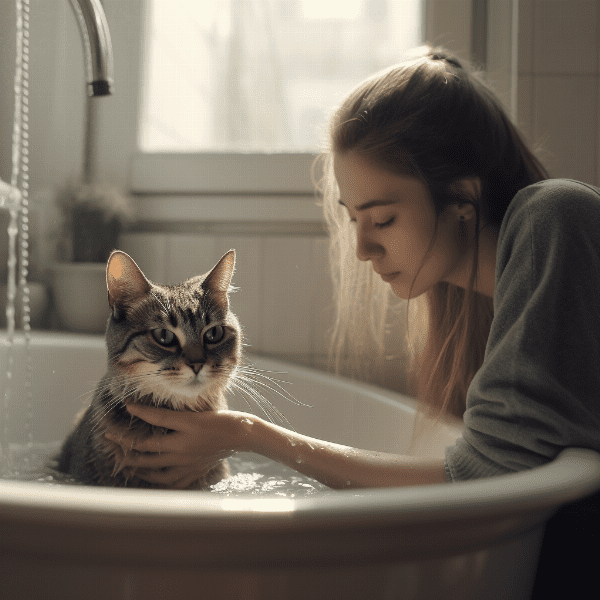Table of Contents
Gather Your Supplies
Before starting the bath, it’s essential to have all the necessary supplies at hand. This will help ensure a smooth and stress-free experience for both you and your feline friend. Here are the things you’ll need:
Shampoo and Conditioner
Choose a cat shampoo and conditioner that’s specifically designed for feline use. Avoid using human shampoos, as they can irritate your cat’s skin and cause allergic reactions. Look for products that are gentle, pH-balanced, and free of harsh chemicals.
Towels
Get several soft, absorbent towels to dry your cat after the bath. It’s a good idea to have a separate towel for your cat’s face and head to avoid getting water in their ears or eyes.
Brush
Have a brush or a comb ready to detangle any knots or mats in your cat’s fur before the bath. This will make the washing process much easier and more comfortable for your cat.
Rubber Mat
Place a rubber mat or a towel on the bottom of the sink or bathtub to prevent your cat from slipping and sliding during the bath. This will also give your cat a secure and comfortable footing.
Treats
Reward your cat with treats for good behavior during and after the bath. Positive reinforcement can go a long way in making the bath a positive experience for your cat.
Gathering all the necessary supplies before the bath can save you time and make the process smoother. With the right supplies, your cat will be well-prepared for a relaxing and successful bath.

Preparing Your Cat for the Bath
Cats are known for their aversion to water, so it’s essential to prepare them mentally and physically for the bath. Here’s how to do it:
Trim Your Cat’s Nails
Trim your cat’s nails a few days before the bath to avoid scratching yourself or your cat during the bath. If you’re uncomfortable trimming your cat’s nails, take them to a professional groomer.
Create a Calm Environment
Cats can sense your mood, so it’s important to stay calm and relaxed during the bath. Play soft music or turn on a white noise machine to create a calming atmosphere. Close the bathroom door to prevent your cat from escaping, but keep a window open for ventilation.
Talk to Your Cat
Speak to your cat in a gentle and reassuring tone to help them feel comfortable and safe. Let your cat sniff the shampoo and conditioner to familiarize them with the scent.
.

Choosing the Right Water Temperature
The temperature of the water can make a big difference in how your cat reacts to the bath. Here’s what you need to know:
Test the Water
Before placing your cat in the sink or bathtub, test the water temperature with your wrist or elbow. The water should be lukewarm, similar to your cat’s body temperature, around 100-102°F (38-39°C). Water that’s too hot or too cold can be uncomfortable for your cat and make them more anxious.
Avoid the Ears and Eyes
When using the spray hose, be careful to avoid your cat’s ears and eyes. Cats are very sensitive to water in these areas and can become agitated or stressed if water gets into their ears or eyes.
Keep the Water Level Low
Keep the water level low to prevent your cat from feeling like they’re drowning. A few inches of water should be sufficient to wash your cat’s fur thoroughly.
By choosing the right water temperature, you can make the bath more comfortable for your cat and reduce their anxiety. Remember to avoid getting water in your cat’s ears and eyes and keep the water level low to prevent them from feeling overwhelmed.
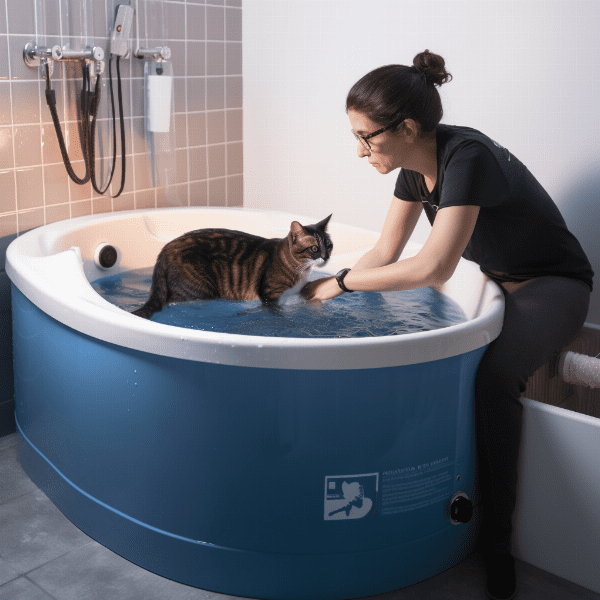
Applying Shampoo and Conditioner
Choosing the right shampoo and conditioner is only half the battle. Here’s how to apply them to your cat:
Dilute the Shampoo
Dilute the shampoo with water according to the instructions on the bottle. Using a concentrated shampoo can irritate your cat’s skin and make the bath more difficult.
Apply the Shampoo
Apply the diluted shampoo to your cat’s fur, starting from the neck and working your way down to the tail. Massage the shampoo into your cat’s fur using gentle, circular motions.
Apply the Conditioner
Apply the conditioner to your cat’s fur, following the instructions on the bottle. Leave the conditioner on for the recommended amount of time, then rinse thoroughly with the spray hose.
Avoid the Face and Ears
Be careful to avoid your cat’s face and ears when applying shampoo and conditioner. Use a damp washcloth to clean your cat’s face, and avoid getting water in their ears.
.
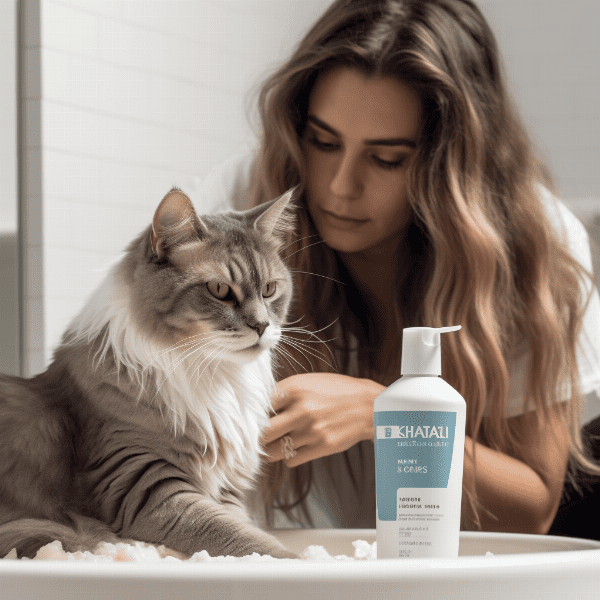
Scrubbing Your Cat Gently
Now that you’ve applied the shampoo and conditioner, it’s time to scrub your cat gently. Here’s how to do it:
Use Your Fingers
Instead of using a brush or a comb, use your fingers to scrub your cat’s fur gently. This will help you feel for any knots or tangles and prevent any unnecessary pulling or tugging.
Start from the Neck
Start scrubbing from the neck and work your way down to the tail. Use gentle circular motions to massage the shampoo and conditioner into your cat’s fur.
Focus on Problem Areas
If your cat has any particularly dirty or matted areas, focus on those first. Use your fingers to gently work out the knots or tangles, and then move on to the rest of the fur.
Be Gentle
Be gentle when scrubbing your cat’s fur. Avoid applying too much pressure or pulling too hard, as this can cause discomfort or even pain for your cat.
Check for Fleas and Ticks
While scrubbing your cat’s fur, check for any signs of fleas and ticks. These can be removed using a specialized comb or a flea and tick shampoo.
By scrubbing your cat’s fur gently, you can help keep them clean and healthy without causing any discomfort. Remember to use your fingers instead of a brush or comb, focus on problem areas, and check for fleas and ticks while you’re at it.
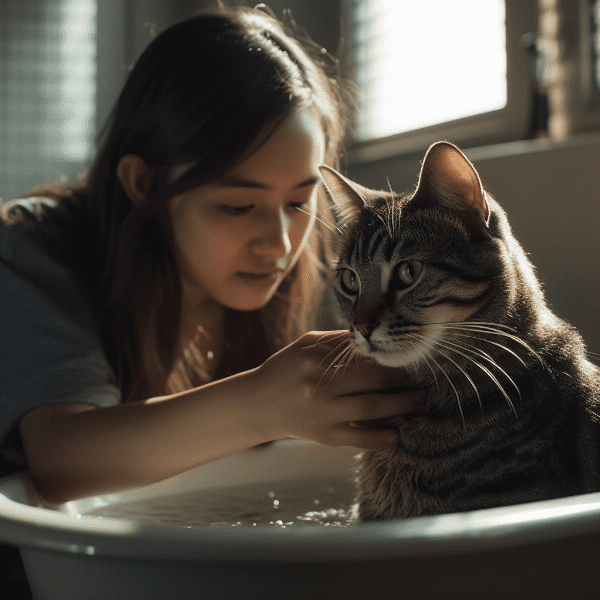
Rinsing Your Cat Thoroughly
After scrubbing your cat’s fur, it’s essential to rinse them thoroughly to remove all the shampoo and conditioner. Here’s how to do it:
Use Lukewarm Water
Use lukewarm water to rinse your cat, avoiding water that’s too hot or too cold. The temperature should be similar to your cat’s body temperature, around 100-102°F (38-39°C).
Use a Spray Hose
Use a spray hose to rinse your cat’s fur, starting from the neck and working your way down to the tail. Keep the water away from your cat’s face and ears to prevent any discomfort or agitation.
Check for Residue
While rinsing, check for any leftover shampoo or conditioner. If you find any, rinse your cat again with the spray hose.
Be Thorough
Be thorough when rinsing your cat’s fur. Make sure to remove all the shampoo and conditioner from their fur, as any leftover residue can cause irritation or allergic reactions.
Check for Matting
While rinsing your cat’s fur, check for any signs of matting. If you find any, use your fingers to gently work out the knots before continuing with the rinse.
By rinsing your cat thoroughly, you can help prevent any discomfort or irritation caused by leftover shampoo or conditioner. Remember to use lukewarm water, be thorough, and check for matting while you’re at it.
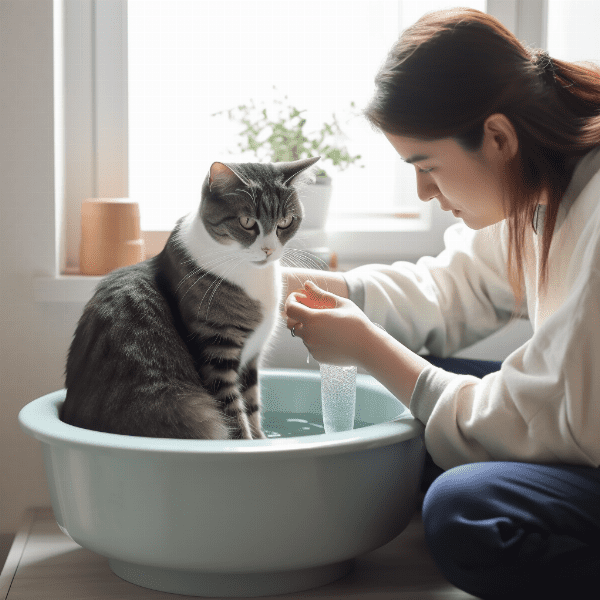
Drying Your Cat
After rinsing your cat’s fur, it’s time to dry them off. Here’s how to do it:
Use Soft Towels
Use soft, absorbent towels to dry your cat’s fur. Avoid using rough or scratchy towels, as these can irritate your cat’s skin.
Squeeze Gently
Squeeze the excess water from your cat’s fur gently using the towels. Avoid rubbing your cat’s fur, as this can cause matting or tangling.
Use a Blow Dryer (Optional)
If your cat is comfortable with the noise, you can use a blow dryer on the lowest setting to dry their fur. Keep the dryer at a safe distance from your cat’s skin, and avoid using hot air, which can burn your cat.
Brush Your Cat’s Fur
Brush your cat’s fur once it’s dry to remove any remaining tangles or mats. Use a soft brush or comb to avoid hurting your cat’s skin.
Reward Your Cat
By drying your cat’s fur properly, you can prevent any discomfort or matting. Remember to use soft towels, avoid rubbing your cat’s fur, and reward them with treats and affection for good behavior.

Rewarding Your Cat
After the bath, it’s important to reward your cat for their good behavior. Here’s how to do it:
Treats
Offer your cat treats for being cooperative and calm during the bath. This positive reinforcement can help your cat associate the bath with a positive experience.
Affection
Offer your cat affection, such as cuddles and pets, to help them relax after the bath. This can help them feel safe and secure, and reassure them that the bath was a positive experience.
Playtime
Engage your cat in playtime after the bath to help them release any built-up energy and stress. This can also help them feel more comfortable and confident in their environment.
Monitor Your Cat
Keep an eye on your cat after the bath to make sure they’re not experiencing any discomfort or irritation. If you notice any unusual behavior or symptoms, contact your veterinarian.
Repeat the Process
Repeat the bathing process as necessary, depending on your cat’s lifestyle and grooming needs. With time and practice, you and your cat can learn to enjoy the bath together.
By rewarding your cat after the bath, you can help them feel positive and relaxed about the experience. Remember to offer treats, affection, and playtime, and monitor your cat’s behavior for any signs of discomfort.

Dealing with Difficult Cats
Not all cats are fond of baths, and some may be more difficult to handle than others. Here’s how to deal with a difficult cat:
Stay Calm
Stay calm and patient when dealing with a difficult cat. Your cat can sense your mood, and becoming frustrated or agitated can make the situation worse.
Use a Towel
Wrap your cat in a towel to prevent them from scratching or biting you during the bath. This can also help them feel more secure and relaxed.
Use Treats
Offer your cat treats throughout the bath to reward good behavior and distract them from the bath. You can also place a few treats on the rubber mat to encourage your cat to stay put.
Take Breaks
Take breaks if necessary to give your cat a chance to calm down and relax. You can also try breaking up the bathing process into shorter, more manageable sessions.
Consider Professional Help
If your cat is extremely difficult to handle, consider seeking help from a professional groomer or veterinarian. They may be able to offer additional tips and techniques for bathing difficult cats.
Dealing with a difficult cat can be a challenge, but with patience and persistence, you can help your cat feel more comfortable with the bath. Remember to stay calm, use a towel, offer treats, take breaks, and seek professional help if necessary.

Conclusion: Enjoy a Clean and Happy Cat!
Bathing your cat can be a challenging task, but it’s an essential part of keeping them healthy and happy. Here are some key takeaways from this guide:
Gather Your Supplies
Make sure you have all the necessary supplies, such as shampoo, towels, and treats, before starting the bath.
Prepare Your Cat
Brush your cat’s fur, trim their nails, and create a calm environment to help them feel comfortable and safe.
Choose the Right Water Temperature
Use lukewarm water and a spray hose to avoid getting water in your cat’s face and ears.
Apply Shampoo and Conditioner
Dilute the shampoo, avoid the face and ears, and rinse thoroughly to prevent any irritation or discomfort for your cat.
Scrub Your Cat Gently
Use your fingers instead of a brush or comb, focus on problem areas, and check for fleas and ticks.
Rinse Thoroughly
Use lukewarm water, be thorough, and check for matting while you’re at it.
Dry Your Cat
Use soft towels, avoid rubbing your cat’s fur, and reward them with treats and affection for good behavior.
Dealing with Difficult Cats
Stay calm, use a towel, offer treats, take breaks, and seek professional help if necessary.
With these tips and techniques, you can enjoy a clean and happy cat without any stress or discomfort. Remember to stay patient and positive, and take breaks if necessary.



